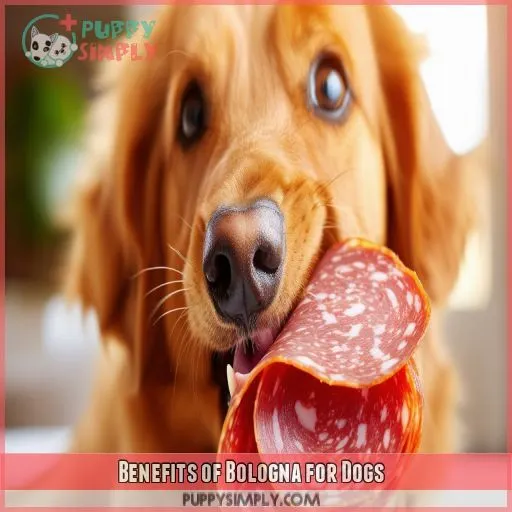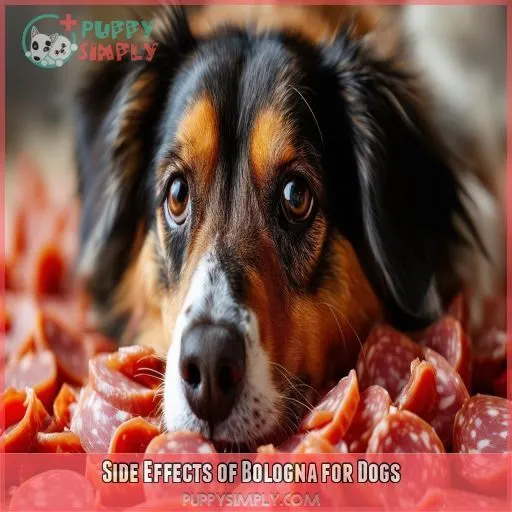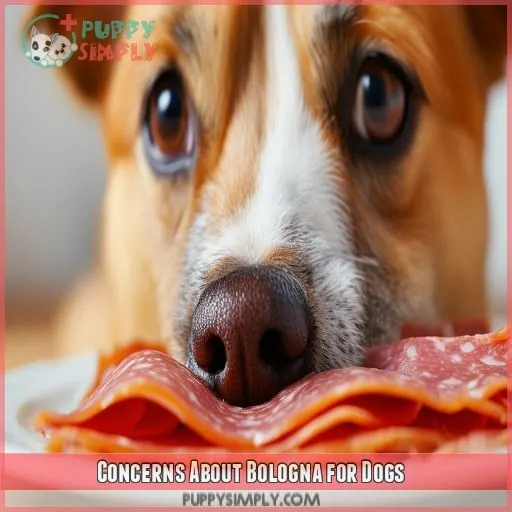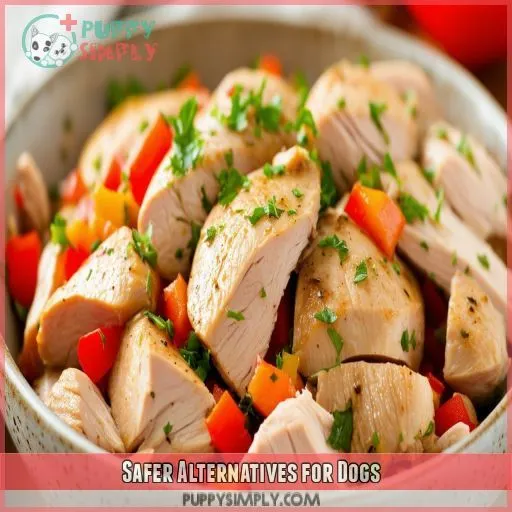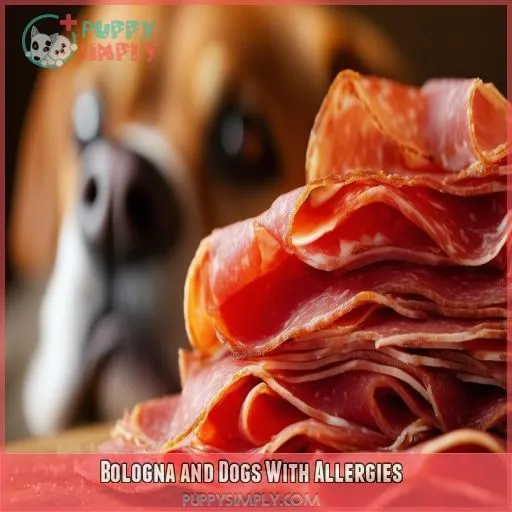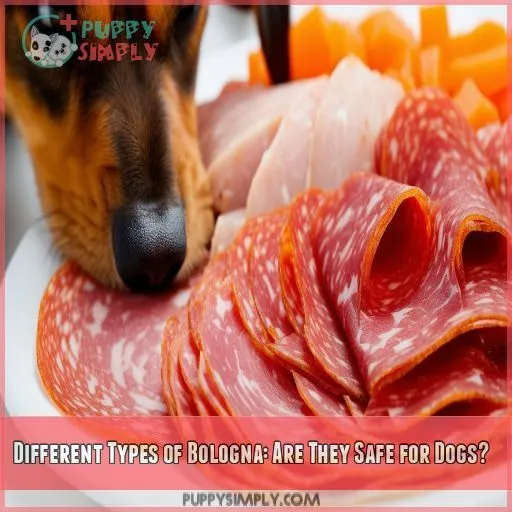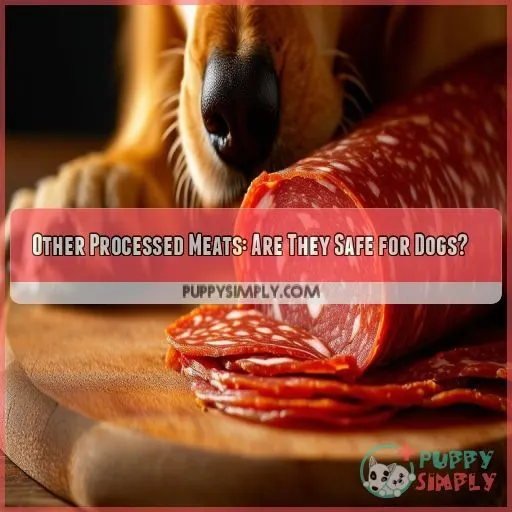This site is supported by our readers. We may earn a commission, at no cost to you, if you purchase through links.
 Bologna is a popular lunch meat, but is it safe for your dog to eat?
Bologna is a popular lunch meat, but is it safe for your dog to eat?
The short answer is yes, dogs can eat bologna, but…
Is it good for them? Let’s find out.
Table Of Contents
- Key Takeaways
- Can Dogs Eat Bologna?
- Is Bologna Bad for Dogs?
- Benefits of Bologna for Dogs
- Side Effects of Bologna for Dogs
- Concerns About Bologna for Dogs
- Safer Alternatives for Dogs
- Bologna and Dogs With Allergies
- Different Types of Bologna: Are They Safe for Dogs?
- Other Processed Meats: Are They Safe for Dogs?
- Frequently Asked Questions (FAQs)
- What if my dog ate a piece of bologna?
- What deli meats can dogs eat?
- Which meat can dogs not eat?
- Can a dog eat cheese?
- Can dogs eat bologna in moderation?
- What are the dangers of bologna for dogs?
- Can dogs with allergies eat bologna?
- Are there any benefits to feeding bologna to dogs?
- Are there any healthy alternatives to bologna for dogs?
- Conclusion
Key Takeaways
- Bologna may be a tasty treat for your dog, but it’s not a healthy option due to its high salt, fat, and preservative content. It’s best given as an occasional treat, not a regular part of their diet.
- Bologna is a processed meat, and while it’s not toxic to dogs, the high levels of salt, fat, and preservatives can lead to health issues such as obesity, heart disease, and digestive problems.
- There are safer alternatives to bologna that you can offer your dog, such as leaner protein sources like chicken, turkey, or beef, which provide high-quality protein without the potential health risks.
- Consult your veterinarian if you’re unsure about your dog’s allergies or dietary needs. They can provide personalized advice and recommendations to ensure your furry friend stays happy and healthy.
Can Dogs Eat Bologna?
Bologna, which originated in Bologna, Italy, is a type of processed meat known as mortadella. The American version is made from a combination of meat ingredients, earning it the nickname "mystery meat" due to its unclear and varied contents.
What is Bologna?
Bologna is a type of processed meat, often referred to as a sausage or luncheon meat.
It originated in Bologna, Italy, where it’s known as mortadella.
Bologna is made from a combination of meat ingredients and has a paste-like consistency.
It’s a popular food item, commonly used in sandwiches.
However, it has been labeled as "mystery meat" due to its unclear and varied ingredients, which may include meat from different animal sources.
Origins of Bologna
Bologna originated in the city of Bologna, Italy, and was originally known as mortadella.
- Bologna is a type of luncheon meat.
- It’s often referred to as "mystery meat" due to its unclear ingredients.
- The American version is a processed meat paste made from a combination of different meats.
American Bologna Vs. Italian Mortadella
Bologna, originating from the city of Bologna in Italy, is known as mortadella.
This Italian mortadella differs from American bologna, which is often a processed meat paste with unclear ingredients, earning it the nickname "mystery meat."
While American bologna is a luncheon meat, Italian mortadella has a richer history and is made from ground meat, often pork, with added nitrates, salt, and preservatives.
Is Bologna Bad for Dogs?
Bologna is a highly processed meat, and while it’s not toxic to dogs, it’s not a healthy snack option. It’s best to avoid giving bologna to dogs due to its high levels of salt, fat, and preservatives, which can lead to health issues such as obesity, heart disease, and digestive problems.
Processed Meats and Cancer Risk
Processed meats and cancer risk—is bologna bad for your dog’s health? The short answer is yes. Bologna is a processed meat, and processed meats have been linked to an increased risk of cancer and other health issues in both humans and dogs.
Here are some key points to keep in mind:
- Study results: While human studies have shown a clear link, there’s limited research on dogs specifically. It’s safe to assume that the high levels of sodium, fat, and preservatives in bologna can have similar negative effects.
- Cancer risk: Processed meats are associated with an increased risk of bowel cancer in humans, and nitrates, commonly found in bologna, are a particular concern.
- Health concerns: The high fat and calorie content can lead to weight gain and obesity, impacting your dog’s overall health.
High Salt Content and Heart Disease
Bologna’s high salt content can have negative effects on your dog’s health.
Too much sodium in a dog’s diet can lead to increased water retention, raising their blood pressure and putting them at risk for heart disease and other cardiovascular issues.
Obesity is also a concern, as high-sodium foods can trigger excessive thirst and urination, disrupting your dog’s fluid balance.
Talk to your vet about your dog’s diet to make sure they stay healthy.
Nitrosamines and Cancer Link
Nitrosamines and the Cancer Link:
Bologna contains nitrosamines, linked to an increased risk of cancer. While a single piece of bologna won’t cause harm, the potential link between nitrosamines, cancer, and stomach issues is a concern.
Key points to remember:
- Nitrosamines: Linked to cancer risk.
- Bologna: Potential health risks for dogs.
- Alternatives: Healthier options available.
Benefits of Bologna for Dogs
Bologna does provide a moderate amount of protein, which is essential for building cells and tissue in dogs. However, other food options offer similar or higher protein levels and are much healthier choices.
Moderate Protein Source
Bologna does provide a moderate amount of protein, which is essential for building cells and tissue in your dog’s body. However, other food options offer similar or higher protein levels and are much healthier.
| Food Type | Protein Source | Benefits |
|---|---|---|
| Bologna | Moderate | Building cells and tissue |
| Healthier Options | Similar or higher | To be discussed in the next subtopic |
Comparison to Healthier Protein Options
Bologna provides a moderate amount of protein, which is essential for building cells and tissue in dogs.
However, there are healthier protein options available that offer similar or higher protein levels.
Leaner protein sources like chicken or turkey are better choices.
You can also consider fish, such as salmon, which is rich in omega-3 fatty acids and provides numerous health benefits for your dog’s skin, coat, and cognitive function.
Beef is another option, offering high-quality protein and essential nutrients like zinc and iron.
These alternatives provide a more balanced and nutritious diet for your dog, ensuring their protein needs are met without the potential health risks associated with bologna.
Side Effects of Bologna for Dogs
While a small piece of bologna might be a tasty treat for your dog, it’s important to be aware of the potential side effects. The high fat and calorie content can lead to weight gain and obesity, and the nitrates in bologna increase the risk of digestive and bowel cancers.
Weight Gain and Obesity
While bologna provides a moderate amount of protein, which is essential for building cells and tissue, the high fat and calorie content can lead to:
- Weight gain
- Obesity
- Heart disease
Digestive Issues and Bowel Cancer
Bologna’s high fat content and unhealthy fats can cause digestive issues in dogs. These issues can lead to pancreatitis, a serious and potentially fatal condition. Additionally, the high salt content in bologna can cause gastrointestinal distress, further exacerbating digestive problems.
Hypertension and Heart Disease
Bologna is a no-go for your dog’s heart health. The high salt content in bologna can lead to:
- High blood pressure
- Heart disease
- Hypertension
Concerns About Bologna for Dogs
While bologna may be a tasty treat for your dog, there are some serious concerns about its impact on their health. The high salt, fat, and preservative content can lead to health issues, and some of the additives and preservatives have been linked to an increased risk of cancer and other serious health problems.
Added Preservatives and Corn Syrup
Bologna often contains preservatives and corn syrup, which can pose health risks to dogs. While a single slice of bologna won’t harm your pup, excessive consumption of these additives may lead to health issues over time.
| Additive | Potential Health Risks |
|---|---|
| BHA and BHT | Liver, kidney, and thyroid problems |
| Corn Syrup | Heart disease and diabetes |
There are safer alternatives to bologna that you can offer your dog as treats, such as homemade dog treats made with safe, allergy-friendly meats and ingredients like bananas or eggs.
Toxic Ingredients and Allergy Risks
While bologna isn’t toxic to dogs, certain common ingredients, like onion and garlic powder, are. These ingredients can cause health issues in dogs, so it’s best to avoid giving your dog bologna if it contains these seasonings.
Here are some risks and side effects of feeding bologna to dogs:
- Allergies: Bologna is often referred to as "mystery meat" due to its varied ingredients, which may include different types of meat. This makes it a potential source of allergens for dogs with sensitivities.
- Toxic Ingredients: Onion and garlic powder, commonly found in bologna, are toxic to dogs and can cause serious health issues.
- Other Health Risks: High levels of salt, fat, and preservatives in bologna can contribute to weight gain, obesity, heart disease, and digestive problems in dogs.
Lack of Nutritional Value
Bologna may be a tasty treat for your dog, but it lacks nutritional value and isn’t a healthy option. It’s highly processed and loaded with salt, fat, and preservatives, which can lead to health issues.
| Dog Food | Nutritional Value |
|---|---|
| Bologna | Low |
| Organic Bologna | Moderate |
| Chicken | High |
| Turkey | High |
| Lean Proteins | High |
Bologna is often referred to as a "mystery meat" due to its unclear ingredients, and it’s best to avoid it as a regular part of your dog’s diet.
Safer Alternatives for Dogs
If you’re looking for safer alternatives to bologna, consider making your own dog treats with a meat grinder and safe, allergy-friendly meats. You can also add ingredients like bananas or eggs, but skip the seasonings. For dogs on a raw meat diet, you can skip cooking the meat and add in some finely ground bones for extra nutrition.
Homemade Sausage and Meat Patties
Homemade sausage or meat patties are healthier options for your dog than bologna.
You can use a meat grinder to create finely ground meat, avoiding the mushy paste that food processors make.
If your dog enjoys a raw meat diet, you can skip cooking the meat and add finely ground bones for extra nutrition.
Always choose safe meat sources and avoid ingredients that are toxic or common allergens.
Meat Grinder and Safe Ingredients
When making homemade dog treats or food, use a meat grinder for finely ground meat.
This is instead of a food processor, which can turn it into a mushy paste.
When choosing safe ingredients, pick meats that are suitable for dogs.
Avoid toxic or allergenic ingredients.
You can add bananas or eggs to your dog’s treats.
But leave out any seasonings.
Raw Meat Diet and Finely Ground Bones
If your dog is on a raw meat diet, you can skip cooking the meat and add in some finely ground bones for extra nutrition. Here are some key considerations:
- Bone Health: Finely ground bones provide essential calcium and phosphorus, supporting bone health and strength.
- Diet Risks: Raw meat carries a risk of bacterial contamination, so make sure you source it from reputable suppliers.
- Grinder Safety: Use a bone grinder, not a food processor, to avoid creating a dangerous, mushy paste.
- Meat Sources: Opt for chicken, turkey, or beef, and avoid raw pork or wild game, which may have parasites or bacteria.
Bologna and Dogs With Allergies
If your dog has allergies, bologna’s "mystery meat" status can be a concern. Unknown allergens in bologna might trigger an allergic reaction in your dog. To be safe, avoid giving bologna to dogs with known allergies, and opt for allergy-specific treats instead. Consult your veterinarian for guidance on managing your dog’s allergies and safe treat options.
Unknown Allergens and Accidental Ingestion
Bologna is often called "mystery meat" because its ingredients are unclear. This can be risky if your dog has allergies, as they may unknowingly consume an allergen. Bologna can contain various meats, so it’s best for dogs with known allergies to avoid it altogether.
Avoidance and Allergy-Specific Treats
If your dog has known allergies, it’s best to steer clear of bologna altogether. The mystery meat can contain various unknown allergens that may trigger a reaction in your dog. To keep your furry friend safe, opt for allergy-specific treats that are formulated for dogs with allergies.
Consultation With Veterinarian
If you’re unsure about your dog’s allergies or dietary needs, it’s always best to consult your veterinarian. They can provide personalized advice and recommendations for your dog’s diet and treats, ensuring your furry friend stays happy and healthy. Don’t hesitate to seek professional guidance to keep your dog safe and avoid any potential health risks.
Different Types of Bologna: Are They Safe for Dogs?
All types of bologna, from beef to chicken to German varieties, share the same issue: they’re loaded with salt, fat, and preservatives. So, if you’re considering giving your dog a taste, it’s important to remember that these ingredients can pose health risks, regardless of the bologna’s origin or meat source.
Beef, Chicken, Deer, Turkey, and Lebanon Bologna
Bologna comes in a variety of flavors, including beef, chicken, deer, turkey, and even Lebanon bologna.
They’re all processed meats loaded with salt and fat, which can be harmful to dogs.
While a little taste won’t hurt, it’s not a healthy snack for your furry friend.
Stick to leaner protein sources and save the bologna for an occasional treat.
German Bologna and Garlic Bologna
German bologna is highly processed and loaded with salt and preservatives, similar to other bologna types. You really need to be careful about giving your dog German bologna because of some potential health risks. Here are some safety concerns to keep in mind:
- Health Risks: German bologna is highly processed and loaded with preservatives and sodium, which can lead to health issues in dogs.
- Allergy Concerns: German bologna may contain various meats, triggering allergies in sensitive dogs.
- Nutritional Value: While German bologna provides protein, other healthier options offer higher protein levels without the risks.
Plain Bologna and Seasoning Risks
Plain bologna is the safest option for dogs among the various types of bologna. However, it’s still not ideal due to its high salt, fat, and preservative content. Bologna without seasonings or garlic is less likely to cause health issues, but it’s not a nutritious or recommended treat.
Other Processed Meats: Are They Safe for Dogs?
Other processed meats like fried bologna, lunch meat, salami, and weenies are also not recommended for dogs due to their high fat and sodium content. Cheese can be given as a treat in moderation, but it’s important to prioritize leaner protein sources like chicken or turkey and include fresh fruits and vegetables in your dog’s diet.
Fried Bologna and High Fat Content
Fried bologna is a big no-no for dogs due to its high fat and calorie content. Here are some reasons why:
- Obesity: The high fat content can lead to weight gain and obesity, which is just as problematic for dogs as it’s for humans.
- Pancreatitis: Excessive fat consumption can cause pancreatitis, a serious and potentially life-threatening condition in dogs.
- Heart Disease: High levels of fat contribute to cardiovascular issues, affecting your dog’s heart health.
- Digestive Issues: Unhealthy fats can cause gastrointestinal distress, leading to upset stomachs and potential long-term issues.
- Other Health Risks: High-fat foods can also increase the risk of other health problems, including diabetes and certain types of cancer.
Lunch Meat, Salami, and Weenies
Other processed meats like lunch meat, salami, and weenies (hot dogs) are also not ideal for your dog’s health. They’re typically loaded with fat, sodium, and preservatives, which can lead to health issues.
| Processed Meat | Fat Content | Sodium | Preservatives |
|---|---|---|---|
| Lunch Meat | High | High | Yes |
| Salami | High | High | Yes |
| Weenies | High | High | Yes |
Cheese as a Treat and Leaner Protein Sources
Cheese is fine for dogs in small amounts, but it’s high in fat and calories. You should opt for leaner protein sources like chicken or turkey. Here are three things to keep in mind:
- Lean Protein Sources: Chicken and turkey are great alternatives to processed meats like bologna, providing your dog with essential protein while being lower in fat and calories.
- Balanced Diet: Always prioritize a balanced diet for your dog, including a variety of nutritious protein sources, fresh fruits, and vegetables.
- Treats in Moderation: While cheese can be a tasty treat, it should be given in moderation due to its high-fat content. Opt for healthier, low-calorie treats like small pieces of fruit or specially formulated dog treats.
Frequently Asked Questions (FAQs)
What if my dog ate a piece of bologna?
Don’t panic. A small piece of bologna won’t cause serious harm, but it’s not a healthy snack for dogs. Bologna is high in salt, fat, and preservatives, which can lead to health issues over time.
What deli meats can dogs eat?
Deli meats aren’t recommended for dogs due to their high salt, fat, and sodium content. However, small amounts of 100% turkey breast deli meat with no additives are safe for dogs.
Which meat can dogs not eat?
Dogs shouldn’t eat bacon, gammon, cured meats, raw meat, or fish. These foods are high in salt and fat, which can cause vomiting, diarrhoea, indigestion, and lethargy. Raw meat and fish can also carry harmful bacteria and parasites.
Can a dog eat cheese?
Dogs can eat cheese, but only in small amounts and occasionally. Cheese isn’t toxic to dogs, but they’re born with lactose intolerance. Blue cheese should be avoided, as it can make dogs very ill.
Can dogs eat bologna in moderation?
Yes, dogs can eat bologna in moderation. However, it’s not a healthy choice due to its high salt, fat, and preservative content. Bologna also contains potentially toxic ingredients like onion and garlic powder. It’s best to offer bologna as an occasional treat, not a regular meal.
What are the dangers of bologna for dogs?
Bologna’s high fat, sodium, and calorie content can cause obesity, heart disease, high blood pressure, and salt poisoning in dogs. It also contains corn syrup, which can lead to diabetes.
Can dogs with allergies eat bologna?
Dogs with allergies may be able to eat bologna, but it’s not recommended. Bologna is often called "mystery meat" because it can contain various meats, so it’s easy to unknowingly feed your dog an allergen. Always check the ingredients carefully.
Are there any benefits to feeding bologna to dogs?
The only benefit of feeding bologna to dogs is the moderate amount of protein it provides. However, other foods offer similar or higher levels of protein and are healthier.
Are there any healthy alternatives to bologna for dogs?
If you’re looking for a healthier snack option for your furry friend, think of bologna like a ticking time bomb.
While a small piece mightn’t explode immediately, it’s still loaded with sodium, fat, and preservatives that could detonate health issues over time.
Instead, offer your pup a leaner protein source like chicken or turkey, or even a tasty banana or egg.
Conclusion
So, can dogs eat bologna?
Yes, they can, but it’s not an ideal food choice.
While bologna offers a moderate amount of protein, its high salt, fat, and preservative content can lead to health issues like obesity, digestive problems, and even cancer.
It’s best to offer bologna as an occasional treat and opt for leaner, less processed protein sources for your dog’s regular diet.
Always consult your veterinarian if you have concerns about your dog’s nutrition or health.


